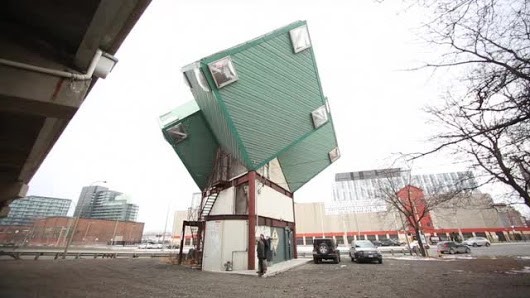
Every now and again a real unique property appears on the market and we have to say that the listing of Toronto’s Corktown cubes is just that. Whatever quirky look you imagine from the name it can be nothing as startling as the real thing which was basically designed to use minimal land space but maximise housing space. They have been an integral part of Toronto since 1996 although there is concern that the increase in the value of the land could lead to the demise of the unique Corktown cubes.
Quirky homes
While the Corktown cubes are certainly quirky they were inspired by the famous Dutch design which was introduced to maximise housing space in an area where ground area was limited. Indeed the properties upon which the design was based are now featured in a Dutch museum for all to see. The Canadian version is based at One Sumach Street, Toronto and is obviously visible for many miles, having become something of a landmark. Affordable housing seems to go hand-in-hand with quirky designs as far as the Dutch and Canadians are concerned!
The property itself consists of three cubes which are rented separately offering around 1300 ft.² per unit. The actual ground space used for these properties is minimal as they are perched on a narrow base although there may be an opportunity to buy the surrounding land.
Canadian property prices
While the eye-catching development has been around since 1996 it last change hands in 2002 for a mere $265,000. The latest asking price is said to be well north of $3 million which equates to quite a tidy profit over the years. When you bear in mind that the development was built on “wasteland” this has not only added some interesting views to the region but also shown how the problem of affordable housing and limited ground space can be accommodated.
It is difficult to say with any real confidence whether it is a joy to live in one of these “cube” properties because they are at a rather distinctive angle. However, Martin Trainor has been a tenant in one of the cubes since 2002 so 15 years living in a cube has obviously not put him off.
Concerns about the future
When the initial development was completed there were hopes that more similar cube properties would emerge on nearby wasteland. The situation has changed significantly over the years with an increase in the value of not only the properties but also the land. There is an opportunity to potentially buy the surrounding land which has led to concerns that the cubes themselves could be dismantled and replaced by more traditional housing. If this was the case there is growing momentum for the cubes to be placed in a museum as an example of the challenging housing market.
There is no guarantee that the property will sell at the rumoured high $3 million asking price as this is a significant jump from the previous sale price. At the end of the day such is the value of land in Toronto that any potential buyer may decide to scrap the development and start again with a more traditional style. Alternatively, you could argue that much of the asking price is made up of the unique nature of the current structure?

